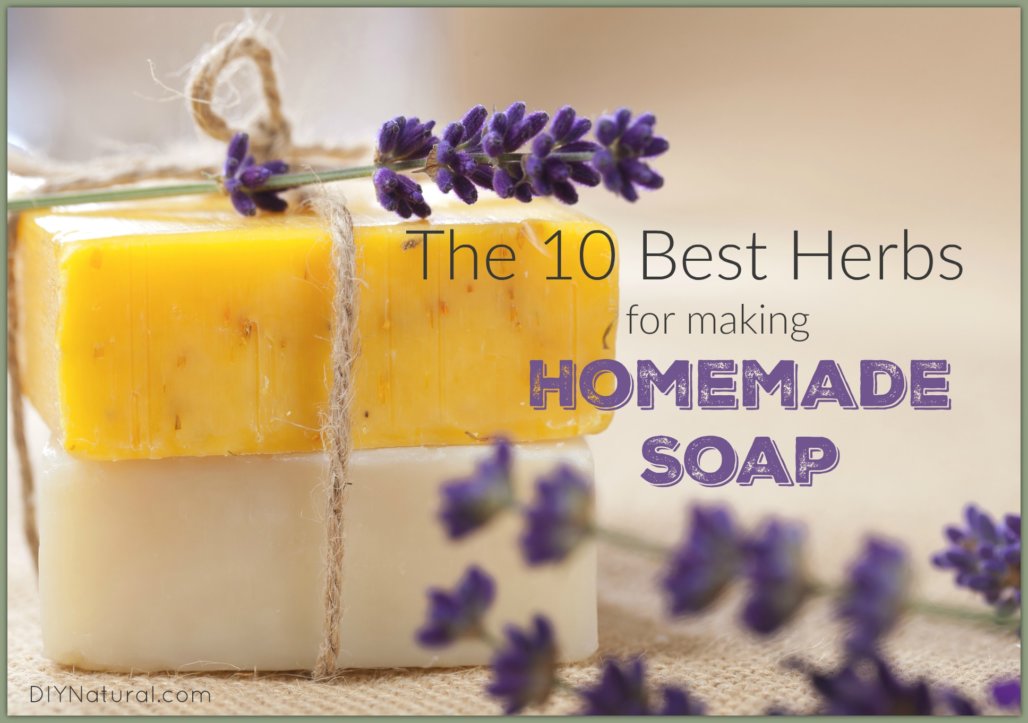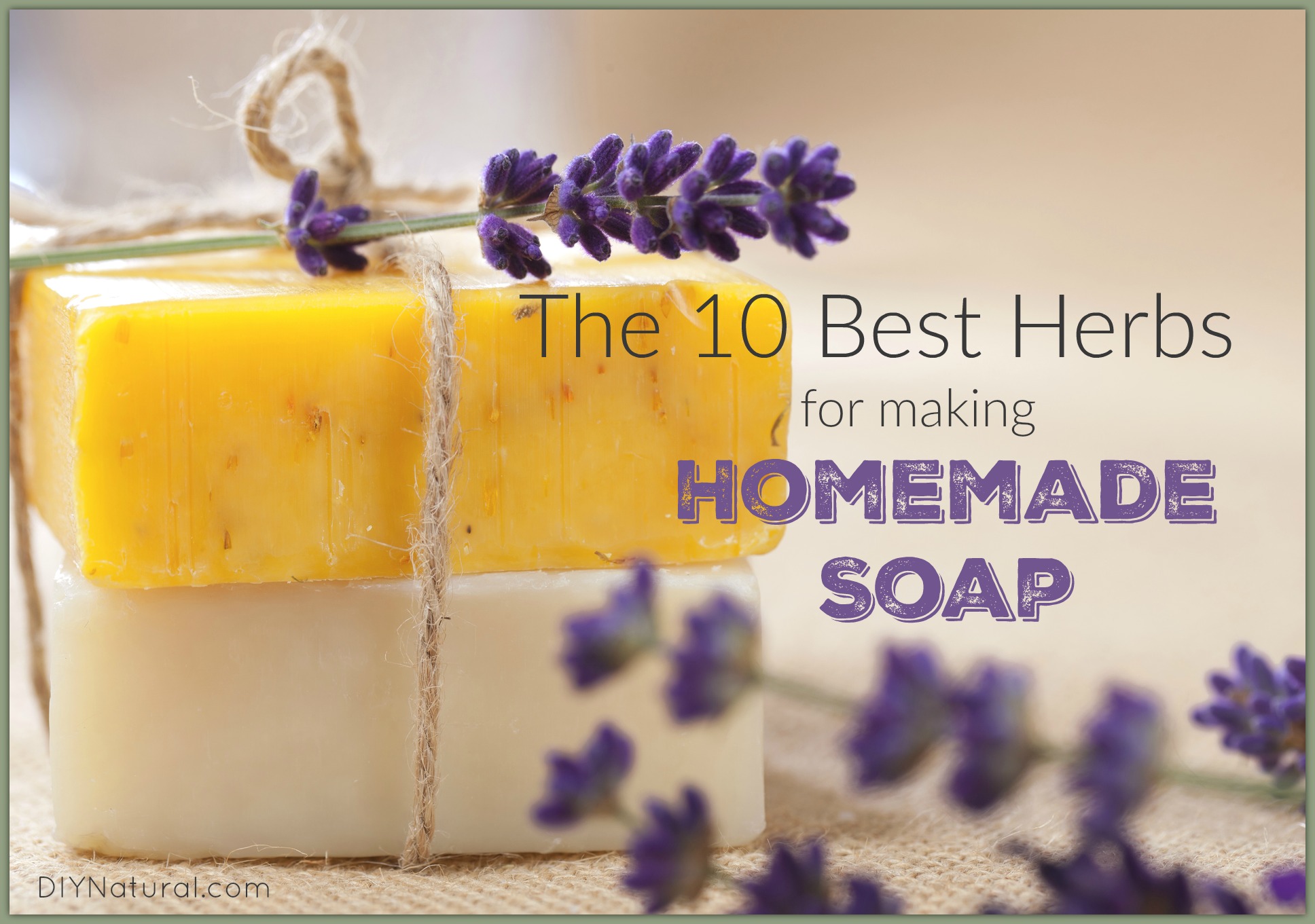
I love making herbal soap. Herbs add texture, scent, and benefits to your skin. You can use most herbs, but some are better than others.
Preparing Herbs for Making Soap
You’ll want to pick your herbs (or gather them from nature) when they are at their peak. Mid-morning is best after the sun has dried the dew off the flowers and leaves, but before the sun dries out the natural oils of the plant. You can dry your herbs naturally in the sun, or in an oven or dehydrator. However it’s done, you’ll want to make sure they are thoroughly dry with no dampness left. Herbs that are not completely dry could produce mold in your herbal soap or the lye may rot them. Either way, it’s undesirable.
When your herbs are dry, store them in a sealed container like a canning jar. This will keep them handy, you can see what’s inside, and they will stay dry. You can leave them as a whole leaf or flower or you can use a coffee/spice grinder to powder them.
10 Best Herbs for Herbal Soap
Lavender
Hands down, lavender is just about the best soap-making herb. The light and clean scent is popular for a reason, and it also provides a sense of comfort. It is antibacterial and can help to heal wounds. Lavender is also well known for its relaxing properties and uses as a natural sleep aid. Use it whole in your herbal soap for a gentle exfoliating property or powdered for even gentler action. (Find organic dried lavender flowers here.)
Chamomile
Chamomile is soft and fragrant. It’s a gentle healing herb and is very soothing. It can also help to remove bacteria on the skin, although not as well as lavender. (Find organic dried chamomile flowers here.)
Calendula
Often called pot marigold, calendula is not in the marigold family, but is in the aster family. Calendula is very healing and can help to remove redness from the skin. Many herbs turn dark after a few weeks in the soap, but calendula herbal soap will hold its color very well for a long time. (Find organic dried calendula here.)
Lemon Balm
When it’s dried, lemon balm loses some of its lemony scents, but it still works very well in soap. Lemon balm is thought to be antiviral and can help to kill germs when you wash with it. It provides a dark green color and a bit rougher exfoliation than lavender or chamomile, while not abrading the skin. (Find organic dried lemon balm here.)
Marshmallow Root
One of the most soothing herbs for herbal soap is marshmallow root. When powdered and used in making soap, the soap becomes soothing and softens the skin very well. Its demulcent action helps to provide moisture for overworked hands. (Find organic marshmallow root powder here.)
Comfrey
Comfrey root, dried and ground into a powder, is added to soap to help heal the skin. It is very effective for acne and poison ivy rash, while not being too harsh. It will not dry the skin out but will help to heal the skin. You can also use the leaf, although the root has more healing properties. (Find organic dried comfrey root here.)
Plantain
One of my favorite herbs for herbal soap is plantain. Not the banana relative, but the herb (or more often weed) found in your yard. It is thought to be very healing, even more so than aloe vera. It is demulcent like marshmallow root, but also has a nice green color that doesn’t fade quickly in soaps. (Find organic plantain leaf powder here.)
Mint
Almost all of the mints are antibacterial, making them a great choice for soap making. There are several different types of mint, some having more of the characteristic minty smell than others. I like peppermint, spearmint, chocolate mint, and my newest favorite – grapefruit mint. It smells just like the peel of the grapefruit and lends a nice quality to soap. (Find organic peppermint leaf or spearmint leaf.)
Rosemary
Perhaps one of the most useful herbs in herbal soap making is rosemary. It is antibacterial, antifungal, and antiviral. It is also full of antioxidants. Rosemary Oil Extract, or ROE, is sold as a preservative for soap and other body care products. I like to powder my rosemary since the leaves are pointy like pine needles. (Find organic rosemary leaf powder here.)
Rose
Rose petals are very soft and they can lend a softening property to soap making. Using rose petals in herbal soap can not only soften the skin but also provides gentle exfoliation. Rose petals contain a lot of Vitamin C, which is also beneficial to the skin. (Find organic dried rose petals here.)
People also use oatmeal extensively in herbal soap making. While it is not an herb, I thought it deserved mention. Oatmeal provides exfoliation while soothing and softening the skin. You can use rolled or old-fashioned oats, whole or ground oats, or you can make oat “milk” by soaking the oats in water and then draining the liquid. Use the liquid as your water portion in making soap.
What is your favorite herb for herbal soap making? Let us know!
*******




Just discovered your site today…so I am eager to try your “no scales required” soap recipe. I am a newbie soaper, so
wish me luck “)
Your toothpaste recipe also looks do-able.
God bless!
Carla